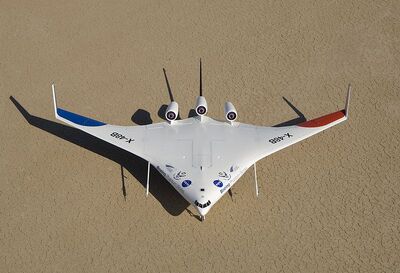
The X-48B from above
The Boeing X-48 is an experimental Unmanned aerial vehicle, that was developed to examine the characteristics of a Blended Wing Body (BWB), a special flying wing variation.
History[]
The X-48 is currently developed under a joint-venture by Boeing Phantom Works and the NASA Langley Research Center. At first a remote-controlled model of the aircraft was built at the Stanford University, with a length of 5.2 m. The next step was the 10.7 m long X-48A, which was built by the NASA Langley Research Center. The first flight of this variant was scheduled to take place in 2004, however the X-48A program was cancelled.
In November of the year 2005, Boeing announced that they are currently working on the third model, the X-48B and now the US Air Force joined the project. And on 20th July 2006, at the Dryden Flight Research Center, the unmanned prototype (wingspan of 6.4 m and a weight of 250 kg) of the X-48B was first flown successfully. The aircraft reached a speed of 222 km/h at an altitude of 2,286 m. In the end of March 2007, the X-48B program was finished after 80 made test flights, making it the most extensively UAV project, ever undertaken by the NASA. The present record holder was the X-45 with 40 flights. The X-48B met all the requirements. In future, the X-48B is going to be equipped with a new fly-by-wire system for the “Phase 1.5” flight test series for the “Environmentally Responsible Aviation Project” of the NASA to

Boeing X-48C Blended Wing Body first-ever flight
collect data for more environmental aviation, with the aim of reducing noise, lowering fuel consumption and greenhouse gas production.
In 2012, a modified X-48C with two, instead of three engines, was tested.